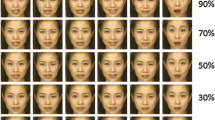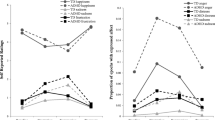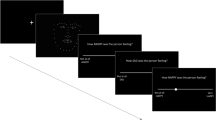Abstract
Twenty six children with autism, 24 children with developmental disabilities, and 15 typically developing children participated in tasks in which an adult displayed emotions. Child focus of attention, change in facial tone (i.e., hedonic tone), and latency to changes in tone were measured and summary scores of emotional contagion were created. Group differences existed in the ratio of episodes that resulted in emotional contagion. Correlations existed between measures of emotional contagion, measures of joint attention, and indices of severity of autism. Children with autism demonstrated muted changes in affect, but these responses occurred much less frequently than in comparison groups. The findings suggest directions for early identification and early treatment of autism.


Similar content being viewed by others
References
American Psychiatric Association (1994). Diagnostic and statistical manual (4th ed.). Washington, D.C.: APA.
Bacon, A. L., Fein, D., Morris, R., Waterhouse, L., & Allen, D. (1998). The responses of autistic children to the distress of others. Journal of Autism and Developmental Disorders, 28, 129–142.
Charman, T., Swettenham, J., Baron-Cohen, S., Cox, A., Baird, G., & Drew, A. (1997). Infants with autism: An investigation of empathy, pretend play, joint attention, and imitation. Developmental Psychology, 33, 781–789.
Charman, T. (2004). Matching preschool children with autism spectrum disorders and comparison children for language ability: Methodological challenges. Journal of Autism and Developmental Disorders, 34, 65–73.
Corona, R., Dissanayake, C., Arbelle, S., Wellington, P., & Sigman, M. (1998). Is affect aversive to young children with autism? Behavioral and cardiac responses to experimenter distress. Child Development, 69, 1494–1502.
Dawson, G., Hill, D., Spencer, A., Galpert, L., & Watson, L. (1990). Affective exchanges between young autistic children and their mothers. Journal of Abnormal Child Psychology, 18, 335–345.
Dawson, G., & Lewy, A. L. (1989). Arousal, attention, and the socioemotional impairments in individuals with autism. In G. Dawson (Ed.) Autism: Nature, diagnosis, & treatment (pp. 49–74). New York NY: Guilford Press.
Dawson, G., Toth, K., Abbott, R., Osterling, J., Munson, J. Estes, A., & Liaw, J. (2004). Early social attention impairments in autism: Social orienting, joint attention, and attention to distress. Developmental Psychology, 40, 271–283.
Emde, R. (1983). The prerepresentational self and its affective core. Psychoanalytic Study of the Child, 38, 165–192.
Greenspan, S. I., & Wieder, S. (1998). The child with special needs: encouraging intellectual and emotional growth. Reading, MA: Perseus Books.
Gutstein, S. E., & Sheely, R. K. (2002). Relationship development intervention with young children: Social and emotional development activities for Asperger Syndrome, autism, PPD and NLD. Philadelphia, PA: Jessica Kingsley Publishers.
Hatfield, E., Cacioppo, J. T., & Rapson, R. (1994). Emotional contagion. New York: Cambridge University Press.
Hobson, R. P., & Lee, A. (1999). Imitation and identification in autism. Journal of Child Psychology & Psychiatry, 40, 649–659.
Joseph, R. M., & Tager-Flusberg, H. (1997). An investigation of attention and affect in children with autism and down syndrome. Journal of Autism and Developmental Disorders, 27, 385–396.
Keltner, D., & Kring, A. M. (1998). Emotion, social function, and psychopathology. Review of General Psychology, 2, 320–342.
Lord, C. (1995). Follow-up of two-year-olds referred for possible autism. Journal of Child Psychology & Psychiatry, 36, 1365–1382.
Lord, C., Rutter, M., & Le Couteur, A. (1994). Autism diagnostic interview – revised: A revised version of a diagnostic interview for caregivers of individuals with possible pervasive developmental disorders. Journal of Autism and Developmental Disorders, 24(5), 659–685.
Lord, C., Risi, A., DiLavore, P., & Rutter, M., (1999). Autism Diagnostic Observation Schedule-Generic (ADOS-G). Los Angeles, CA: The Western Psychological Corporation.
Lord, C., Rutter, M., & DiLavore, P. (1997). Autism Diagnostic Observation Schedule-Generic (ADOS-G). Washington, DC: The Psychological Corporation.
Loveland, K. A. (2001). Toward an ecological theory of autism. In J. A. Burack, T. Charman et al (Eds.), The development of autism: Perspectives from theory and research (pp. 17–37). Mahwah, NJ: Lawrence Erlbaum Associates, Inc.
Mullen, E. (1989). Mullen scales of early learning. Cranston, RI: T.O.T.A.L. Child, Inc.
Mundy, P., Hogan, A., & Doehring, P. (1996). A preliminary manual for the abridged Early Social Communication Scales (ESCS). Coral Gables, FL: University of Miami.
Repacholi B. M., & Gopnick, A. (1997). Early reasoning about desires: Evidence from 14- and 18-month-olds. Developmental Psychology, 33, 12–21.
Rogers, S. J. (1999). An examination of the imitation deficit in autism. In J. Nadel, G. Butterworth et al. (Eds.) Imitation in Infancy: Cambridge studies in cognitive perceptual development (pp. 254–283). New York: Cambridge University Press.
Rogers, S. J., Hall, T., Osaki, D., Reaven, J., & Herbison, J. (2001). The Denver model: A comprehensive, integrated educational approach to young children with autism and their families. In Handleman, J. S., & S. L. Harris (Eds.), Preschool Education Programs for Children with Autism (2nd ed., pp. 95–134). Austin, Texas: Pro-Ed.
Seibert, J., Hogan, A., & Mundy, P. (1982). Assessing social interactional competencies: The Early Social–Communication Scales. Infant Mental Health Journal, 3, 244–258.
Sigman, M., Kasari, C., Kwon, J. H., & Yirmiya, N. (1992). Responses to the negative emotions of others by autistic, mentally retarded, and normal children. Child Development, 63, 796–807.
Snow, M. E., Hertzig, M. E., Shapiro, T. (1987). Expression of emotion in young autistic children. Journal of the American Academy of Child and Adolescent Psychiatry, 26, 836–838.
Sparrow S. S., Balla, D. A., & Cicchetti, D. (1984). Vineland Adaptive Behavior Scales. Circle Pines, MN: American Guidance Service.
Stone, W. L., Lee, E. B., Ashford, L., Brissie, J., Hepburn, S. L., Coonrod, E. E., & Weiss, B. H. (1999). Can autism be diagnosed accurately in children under 3 years? Journal of Child Psychology & Psychiatry, 40, 219–226.
Stern, D. N. (1985). The interpersonal world of the human infant. New York: Basic Books.
Williams, J. H. G., Whiten, A., & Singh, T. (2004). A systematic review of action imitation in autistic spectrum disorder. Journal of Autism and Developmental Disorders, 34(3), 285–299.
Yirmiya, N., Kasari, C., Sigman, M., & Mundy, P. (1989). Facial expressions of affect in autistic, mentally retarded and normal children. Journal of Child Psychology and Psychiatry, 30, 725–735.
Zahn-Waxler, C., & Radke-Yarrow, M. (1990). The origins of empathic concern. Motivation and Emotion, 14, 107–130.
Acknowledgments
First Author was supported by an institutional NRSA Postdoctoral Research Training Program Grant, “Development of Maladaptive Behavior,” # NIMH 5 T32 MH15442-24 and a young researcher’s award from the Developmental Psychobiology Research Group (DPRG). This research was funded by grants from the NICHD, #PO1/U19 HD035468, to Fifth Author. It is part of the NICHD/NIDCD Collaborative Program of Excellence in Autism (CPEA). Third Author was supported by NIH grant 2T32MH15780-20. Fifth Author was also supported by Maternal and Child Health Bureau Grant # 2T73MC00011-04, and by the Administration on Developmental Disabilities Grant # 90DD0414. Thanks to Angela John, Athena Hayes, and Jennifer Stella for their help with coding and to the children and families for their participation.
Author information
Authors and Affiliations
Corresponding author
Rights and permissions
About this article
Cite this article
Scambler, D.J., Hepburn, S., Rutherford, M.D. et al. Emotional Responsivity in Children with Autism, Children with Other Developmental Disabilities, and Children with Typical Development . J Autism Dev Disord 37, 553–563 (2007). https://doi.org/10.1007/s10803-006-0186-y
Published:
Issue Date:
DOI: https://doi.org/10.1007/s10803-006-0186-y




